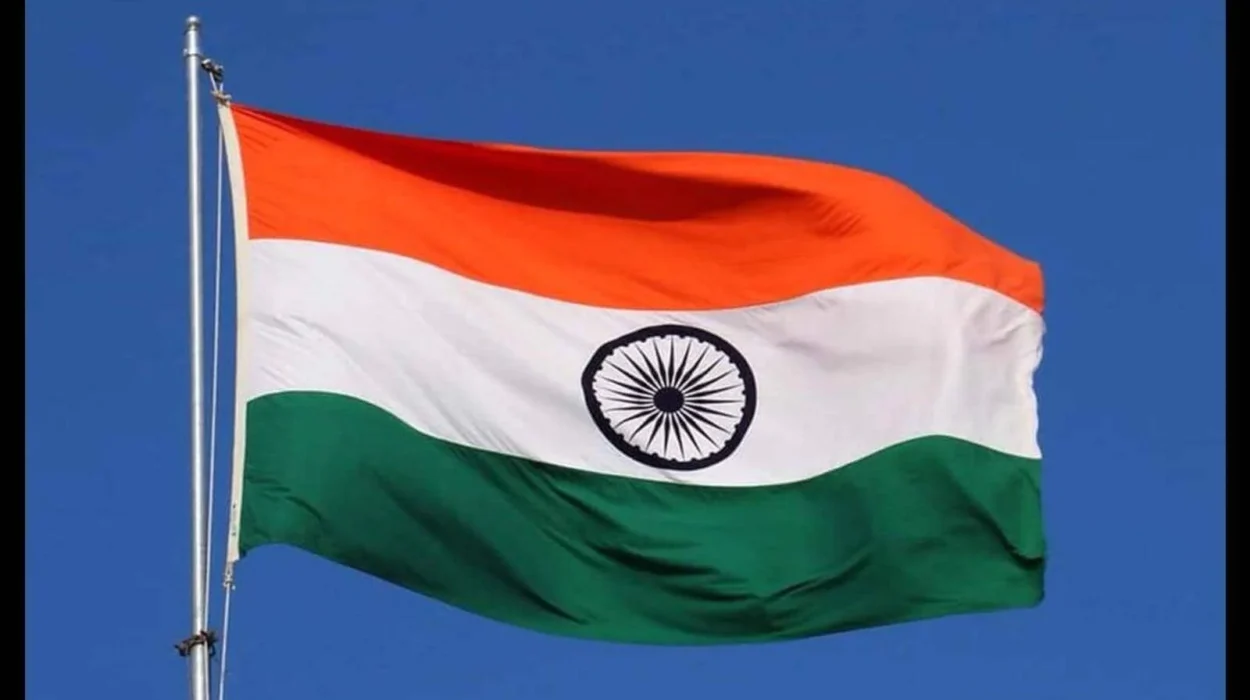The Indian national flag is a symbol of unity and pride for the country and its people. The flag is designed with three equal horizontal bands of saffron (top), white, and green with a blue wheel (Ashoka Chakra) in the center. The significance of the colors and the Ashoka Chakra on the flag holds a deep meaning and history. The flag is not just a symbol of the country but also a representation of its rich culture and heritage. In this blog post, we will take a closer look at the history of the Indian flag, the meaning of its colors, and its importance in the nation’s identity.
Significance of the Indian flag and its colors
The Indian national flag is a symbol of unity and pride for the country and its people. The flag is designed with three equal horizontal bands of saffron (top), white, and green with a blue wheel (Ashoka Chakra) in the center. Each color and the Ashoka Chakra on the flag holds a deep meaning and significance.
The saffron color represents sacrifice, courage and selflessness. The white color symbolizes peace and truth, and the green color represents faith and chivalry. Together, the three colors represent the ideals of sacrifice, peace, and faith that form the foundation of the Indian nation.
The Ashoka Chakra in the center of the flag, which is a 24-spoke wheel, is derived from the Ashoka Chakra of the Sarnath Lion Capital, which was erected by the Emperor Ashoka in the 3rd century BC. The Ashoka Chakra symbolizes the eternal wheel of law and justice and represents the continuity of the Indian civilization.
Furthermore, the flag is not just a symbol of the country but also a representation of its rich culture and heritage. The flag is a reminder of the sacrifices made by the freedom fighters and the struggles for independence. It also symbolizes the unity and diversity of the country, representing the various religious, linguistic, and cultural identities that make India unique. The flag is a source of national pride and inspiration for all citizens, and it is a symbol of India’s sovereignty, integrity and national identity.
The History of the Indian Flag
The Evolution of the Indian flag and its different versions
The evolution of the Indian national flag has been a long and interesting journey, reflecting the country’s political and social changes over the years.
The first version of the Indian national flag was hoisted on August 7, 1906, at the Parsee Bagan Square in Calcutta (now Kolkata) by Madam Bhikaji Cama, Dr. Pherozeshah Mehta, and Veer Savarkar. The flag featured three horizontal bands of green, yellow and red, with eight lotuses arranged in a row on the middle yellow band, and a crescent and a star on the top green band.
In 1921, the Indian National Congress adopted a new flag, which featured a red background with the Union Jack in the top left corner and the star of India in the center. The flag was used during the Non-Cooperation Movement and was also hoisted on the Congress’s session in 1923.
In 1931, the Indian National Congress adopted a new flag, which featured a tricolor of saffron, white and green with a spinning wheel in the center. This flag was hoisted by the Congress party on December 31, 1929, in Lahore by Jawaharlal Nehru. The spinning wheel represented the progress of the nation and the flag was used during the Civil Disobedience Movement.
In 1947, the Constituent Assembly of India adopted the current national flag, which is a tricolor of saffron, white, and green with a blue wheel in the center. The saffron color represents sacrifice, courage and selflessness. The white color symbolizes peace and truth, and the green color represents faith and chivalry.
The Ashoka Chakra in the center of the flag, which is a 24-spoke wheel, is derived from the Ashoka Chakra of the Sarnath Lion Capital, which was erected by the Emperor Ashoka in the 3rd century BC. The Ashoka Chakra symbolizes the eternal wheel of law and justice and represents the continuity of the Indian civilization.
The Indian flag has undergone several changes over the years, reflecting the country’s political and social changes. The current national flag, which was adopted in 1947, is a symbol of unity and pride for the country and its people, and represents the ideals of sacrifice, peace, and faith that form the foundation of the Indian nation.
The Designers and the Significance of the flag
The current Indian national flag was designed by Pingali Venkayya, a freedom fighter and agricultural scientist from Andhra Pradesh, India. The flag was designed in 1921 and was adopted by the Indian National Congress in 1931.
The flag’s design was inspired by the colors of the Indian National Congress and the idea of a spinning wheel, which represented the progress of the nation. The colors of the flag, saffron, white, and green, were chosen to represent the ideals of sacrifice, peace, and faith that form the foundation of the Indian nation.
The Ashoka Chakra in the center of the flag was taken from the Ashoka Chakra of the Sarnath Lion Capital, which was erected by the Emperor Ashoka in the 3rd century BC. The Ashoka Chakra symbolizes the eternal wheel of law and justice and represents the continuity of the Indian civilization.
The significance of the flag lies in its ability to unite the diverse population of India and to represent the country’s sovereignty and integrity. The flag is a reminder of the sacrifices made by the freedom fighters and the struggles for independence. It also symbolizes the unity and diversity of the country, representing the various religious, linguistic, and cultural identities that make India unique. The flag is a source of national pride and inspiration for all citizens.
The Meaning of the Colors
The Indian national flag is designed with three equal horizontal bands of saffron (top), white, and green with a blue wheel (Ashoka Chakra) in the center. Each color on the flag holds a deep meaning and significance.

The saffron color represents sacrifice, courage and selflessness. It is believed that the color saffron represents the sacrifices of the people who fought for India’s freedom. It also symbolizes the spiritual power and strength of the nation.
The white color symbolizes peace and truth. The white color on the flag represents the country’s commitment to peace and non-violence. It also symbolizes the country’s unity and purity of purpose.
The green color represents faith and chivalry. The green color on the flag represents the country’s agricultural and natural wealth. It also symbolizes the country’s commitment to preserving its natural heritage and the welfare of its people.
Together, the three colors represent the ideals of sacrifice, peace, and faith that form the foundation of the Indian nation. The flag is a symbol of unity and pride for the country and its people, and represents the various religious, linguistic, and cultural identities that make India unique.
The Ashoka Chakra in the center of the flag, which is a 24-spoke wheel, is derived from the Ashoka Chakra of the Sarnath Lion Capital, which was erected by the Emperor Ashoka in the 3rd century BC. The Ashoka Chakra symbolizes the eternal wheel of law and justice and represents the continuity of the Indian civilization. The chakra is navy blue in color and contains 24 spokes which represent the 24-hour cycle of the day and the 24-spoke wheel represents the continuous movement of the nation towards progress.
Significance of the Ashoka Chakra in the center
The Ashoka Chakra in the center of the Indian national flag is a significant symbol that holds both historical and symbolic significance.
The Ashoka Chakra is derived from the Ashoka Chakra of the Sarnath Lion Capital, which was erected by the Emperor Ashoka in the 3rd century BC. The Ashoka Chakra symbolizes the eternal wheel of law and justice and represents the continuity of the Indian civilization. The chakra is navy blue in color and contains 24 spokes which represent the 24-hour cycle of the day and the 24-spoke wheel represents the continuous movement of the nation towards progress.
The Ashoka Chakra also represents the country’s commitment to the values of justice, righteousness, and moral order. It symbolizes the country’s adherence to the principles of dharma, which is the moral law that governs individual conduct and social order in Indian philosophy. The Ashoka Chakra also represents the country’s commitment to the rule of law, equality, and non-violence.
The Ashoka Chakra is also significant because it represents the country’s continuity with its ancient heritage and its commitment to progress and modernization. The Ashoka Chakra also represents the country’s commitment to the welfare of its people, as well as its commitment to promoting peace and harmony among all its citizens.
The Importance of the Indian Flag
The Role of the flag in national unity and pride
The Indian national flag plays a significant role in promoting national unity and pride among the citizens of India.
The flag serves as a symbol of the country’s sovereignty and integrity. It represents the ideals of sacrifice, peace, and faith that form the foundation of the Indian nation. The flag is a reminder of the sacrifices made by the freedom fighters and the struggles for independence. It also symbolizes the unity and diversity of the country, representing the various religious, linguistic, and cultural identities that make India unique.
The flag serves as a source of inspiration and motivation for all citizens, promoting a sense of national pride and unity. It is a symbol of the country’s heritage and culture, and it represents the aspirations and hopes of the people of India.
The flag is also an important symbol of national identity. It is a unifying symbol that brings together the diverse population of India, promoting a sense of belonging and shared identity among all citizens.
The flag plays an important role in fostering national unity and pride, particularly during national holidays and celebrations such as Independence Day and Republic Day. The flag is hoisted, paraded and honored as a symbol of the nation’s unity, sovereignty and integrity. The flag also serves as a reminder of the country’s rich cultural heritage and the sacrifices made by the freedom fighters.
In conclusion, the Indian national flag plays a significant role in promoting national unity and pride among the citizens of India. It serves as a symbol of the country’s sovereignty and integrity, a source of inspiration, motivation, and a unifying symbol that promotes a sense of shared identity, belonging and pride among all citizens.
The laws and regulations regarding the use and handling of the flag
The use and handling of the Indian national flag are regulated by the Flag Code of India, 2002, which outlines the guidelines and regulations for the proper display and respect of the flag.

According to the Flag Code of India, the national flag should be flown on all days, including national holidays, and should be flown at half-mast as a mark of respect on days of national mourning.
The flag should be treated with respect at all times and should not be used for commercial or personal gain. The flag should not be used as clothing, drapery, or as a covering for objects. It should also not be defaced by writing or printing on it.
The flag should be flown in a dignified manner and should not be allowed to touch the ground or the floor or be flown in a manner that is likely to allow it to be damaged or disrespected.
It is mandatory to hoist the National flag on certain days like Independence Day, Republic Day, Mahatma Gandhi’s Birthday, and National Days like National Flag Day, etc.
The Flag Code of India also states that the national flag should be flown on buildings and vehicles of the central and state governments, as well as on all government-aided educational institutions.
Conclusion
In conclusion, the Indian national flag is a symbol of unity and pride for the country and its people. It represents the ideals of sacrifice, peace, and faith that form the foundation of the Indian nation. The flag’s design, with three equal horizontal bands of saffron, white, and green with a blue wheel (Ashoka Chakra) in the center, holds a deep meaning and significance. The Ashoka Chakra symbolizes the eternal wheel of law and justice, the continuity of the Indian civilization, the commitment to justice, righteousness, moral order, non-violence, the rule of law and equality. The flag serves as a reminder of the sacrifices made by the freedom fighters and the struggles for independence, it also symbolizes the unity and diversity of the country, representing the various religious, linguistic, and cultural identities that make India unique. The flag plays an important role in promoting national unity and pride, particularly during national holidays and celebrations such as Independence Day and Republic Day. The laws and regulations regarding the use and handling of the flag are outlined in the Flag Code of India, which ensures that the flag is treated with respect and displayed in a dignified manner at all times.
Is it legal to use the national flag on clothing or other personal items?
According to the Flag Code of India, it is not legal to use the national flag on clothing or other personal items. The Flag Code of India, 2002 states that the national flag should not be used as clothing, drapery, or as a covering for objects. It also states that the flag should not be defaced by writing or printing on it.
The Flag Code of India also states that the flag should be treated with respect at all times and should not be used for commercial or personal gain. It should be flown in a dignified manner and should not be allowed to touch the ground or the floor or be flown in a manner that is likely to allow it to be damaged or disrespected.
It’s worth noting that there are also penalties for disrespectful treatment of the national flag as per the Prevention of Insults to National Honour Act, 1971.
Are there any laws or penalties for disrespectful treatment of the national flag?
Yes, there are laws and penalties for disrespectful treatment of the national flag in India. The Prevention of Insults to National Honour Act, 1971, provides for the punishment of persons who prevent the use of the Indian National Flag or show disrespect to it. The Act states that whoever in any public place or in any other place within public view burns, mutilates, defaces, defiles, disfigures, destroys, tramples upon or otherwise shows disrespect to or brings into contempt (whether by words, either spoken or written, or by acts) the Indian National Flag or any part thereof, shall be punished with imprisonment for a term which may extend to three years, or with fine, or with both.
What should be done if the national flag becomes damaged or is no longer in a presentable condition?
If the Indian national flag becomes damaged or is no longer in a presentable condition, it should be disposed of in a respectful manner. The Flag Code of India has specific guidelines for the disposal of worn or damaged national flags. The flag should not be thrown away or treated disrespectfully.
One option is to burn the flag in a private ceremony. The flag should be folded into a triangle, and then set on fire in a dignified manner, with those present standing at attention and saluting the flag as it burns. The ashes should then be buried or scattered in a respectful location.
Another option is to bury the flag in a dignified manner. The flag should be folded into a triangle and then placed in a flag case or a plain box, and then buried in a dignified location.
It is also possible to donate the flag to an organization that will properly dispose of it, such as a veterans’ group or a historical society.
In any case, it is important to ensure that the flag is disposed of in a dignified and respectful manner, as a symbol of the nation’s unity, sovereignty and integrity.











